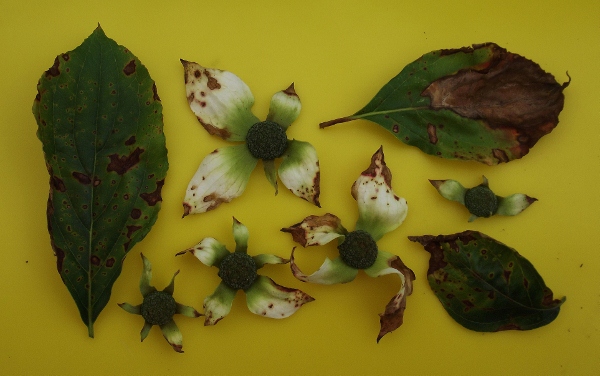Pest and Life Cycle – (Discula destructiva) This fungal disease is prominent during prolonged wet springs accompanied by cool weather, but it may also be prevalent in the fall. It usually begins in the lower part of the crown and works its way up, commonly affecting trees that have experienced drought stress or winter injury. Fruiting bodies overwinter on infected leaves (dead leaves can remain on the tree over winter) and branches, initially releasing spores anytime from May to July (can also be active in the fall) – these are spread by water droplets and wind. Both Eastern (Cornus florida) and Pacific Dogwood (Cornus nuttallii) are very susceptible to this disease.
 Symptoms – Tan to brown spots appear on foliage and flower bracts, with the tips and margins of leaves often dying back completely. Severe infections may cause premature defoliation and branch tip die-back, eventually forming cankers on bark and stems.
Symptoms – Tan to brown spots appear on foliage and flower bracts, with the tips and margins of leaves often dying back completely. Severe infections may cause premature defoliation and branch tip die-back, eventually forming cankers on bark and stems.
Management – Pick-up and discard (do not compost) any foliage that drops prematurely and prune out dead branch tips once the wet weather has subsided.
compost) any foliage that drops prematurely and prune out dead branch tips once the wet weather has subsided.
Prevention – 1. Plant only resistant species or cultivars such as Cornus kousa, Cornus mas, Cornus x ‘Eddie’s White Wonder’ and Cornus florida / kousa hybrids such as ‘Stellar Pink’. 2. Provide ideal growing conditions of good soil drainage, adequate moisture during dry periods and planting sites with good air circulation. 3. Prune and discard (do not compost) any dead or infected branches, as well as the fallen autumn leaves. 4. Do not over-fertilize to try to compensate for poor plant vigor, as this will only result in lush foliage that is more prone to infection.





Hi, I was wondering if you would be okay with giving me permission to use your anthracnose photos in an educational brochure. I would credit your name with the photo. Thanks either way.